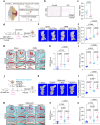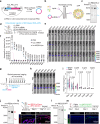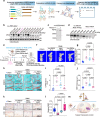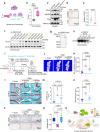Circular RNA-based protein replacement therapy mitigates osteoarthritis in male mice
- PMID: 41006212
- PMCID: PMC12474924
- DOI: 10.1038/s41467-025-63343-z
Circular RNA-based protein replacement therapy mitigates osteoarthritis in male mice
Abstract
In vitro-transcribed and circularized RNAs (ivcRNAs) represent a robust platform for sustained protein translation, offering promising potential for localized therapeutic delivery in joint diseases. Osteoarthritis (OA), the most prevalent degenerative joint disorder, remains a major clinical challenge due to its progressive nature and the lack of disease-modifying treatments. In this study, we identify Musashi2 (Msi2) deficiency in articular chondrocytes as a key contributor to OA pathogenesis. To evaluate the efficacy of ivcRNA-mediated protein replacement therapy, we developed a localized delivery strategy that enables high-yield and prolonged protein expression in chondrocytes. Using a destabilization of the medial meniscus (DMM) mouse model, we demonstrate that intra-articular delivery of ivcRNA encoding MSI2 effectively mitigates OA progression in male mice. Furthermore, therapeutic supplementation of SOX5, a downstream effector of MSI2, via ivcRNA delivery further validates this approach. Our findings establish ivcRNA-based protein replacement as a potential RNA therapeutic strategy for osteoarthritis.
© 2025. The Author(s).
Conflict of interest statement
Competing interests: W.Z., L.C., J.S., and L.L. are named as inventors on patents related to circRNA held by CAS CEMCS. L.C. is a scientific co-founder of RiboX Therapeutics. The remaining authors declare no competing interests.
Figures




References
-
- Parhiz, H., Atochina-Vasserman, E. N. & Weissman, D. mRNA-based therapeutics: looking beyond COVID-19 vaccines. Lancet403, 1192–1204 (2024). - PubMed
-
- Rohner, E., Yang, R., Foo, K. S., Goedel, A. & Chien, K. R. Unlocking the promise of mRNA therapeutics. Nat. Biotechnol.40, 1586–1600 (2022). - PubMed
MeSH terms
Substances
LinkOut - more resources
Full Text Sources
Medical

